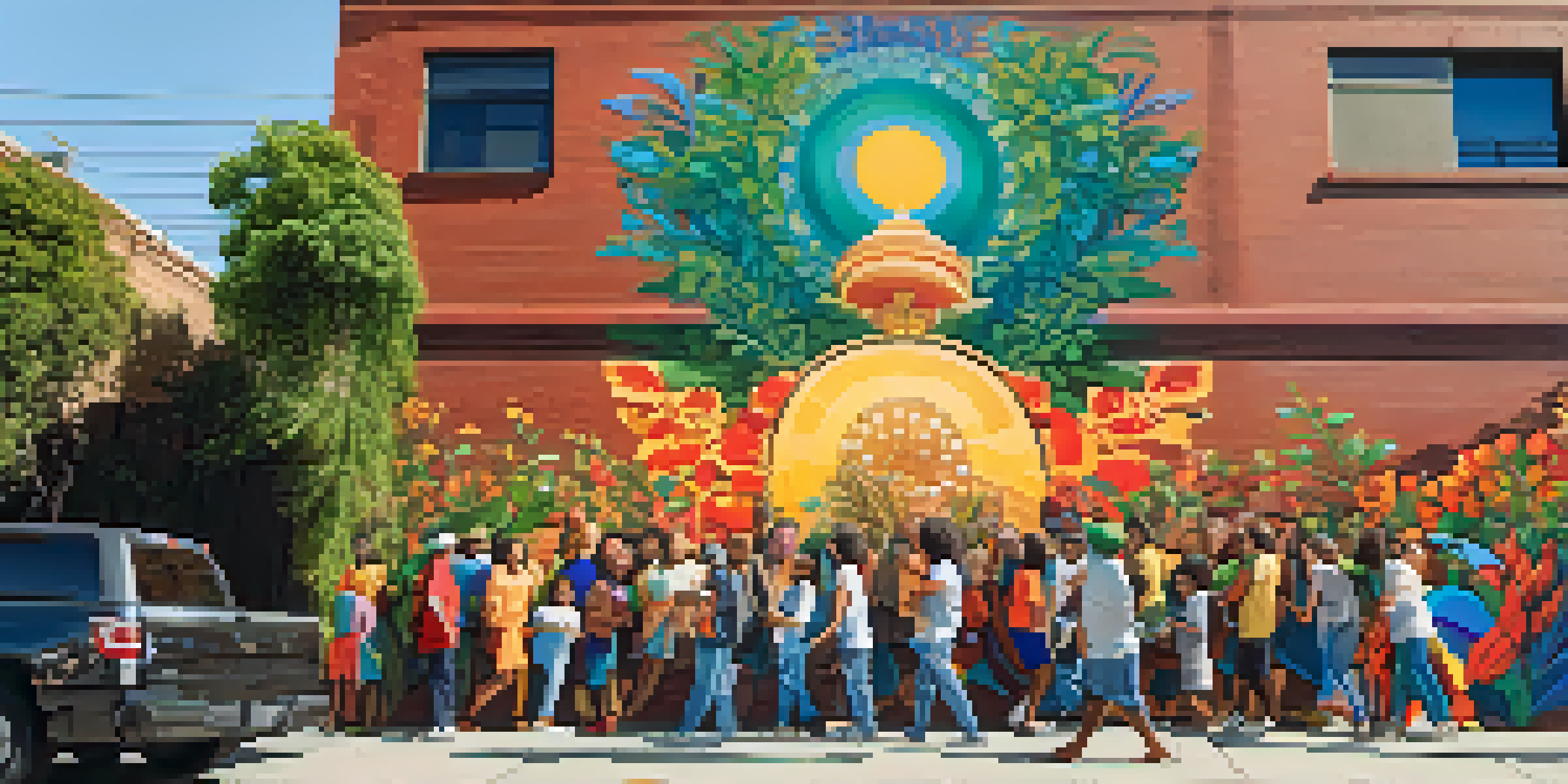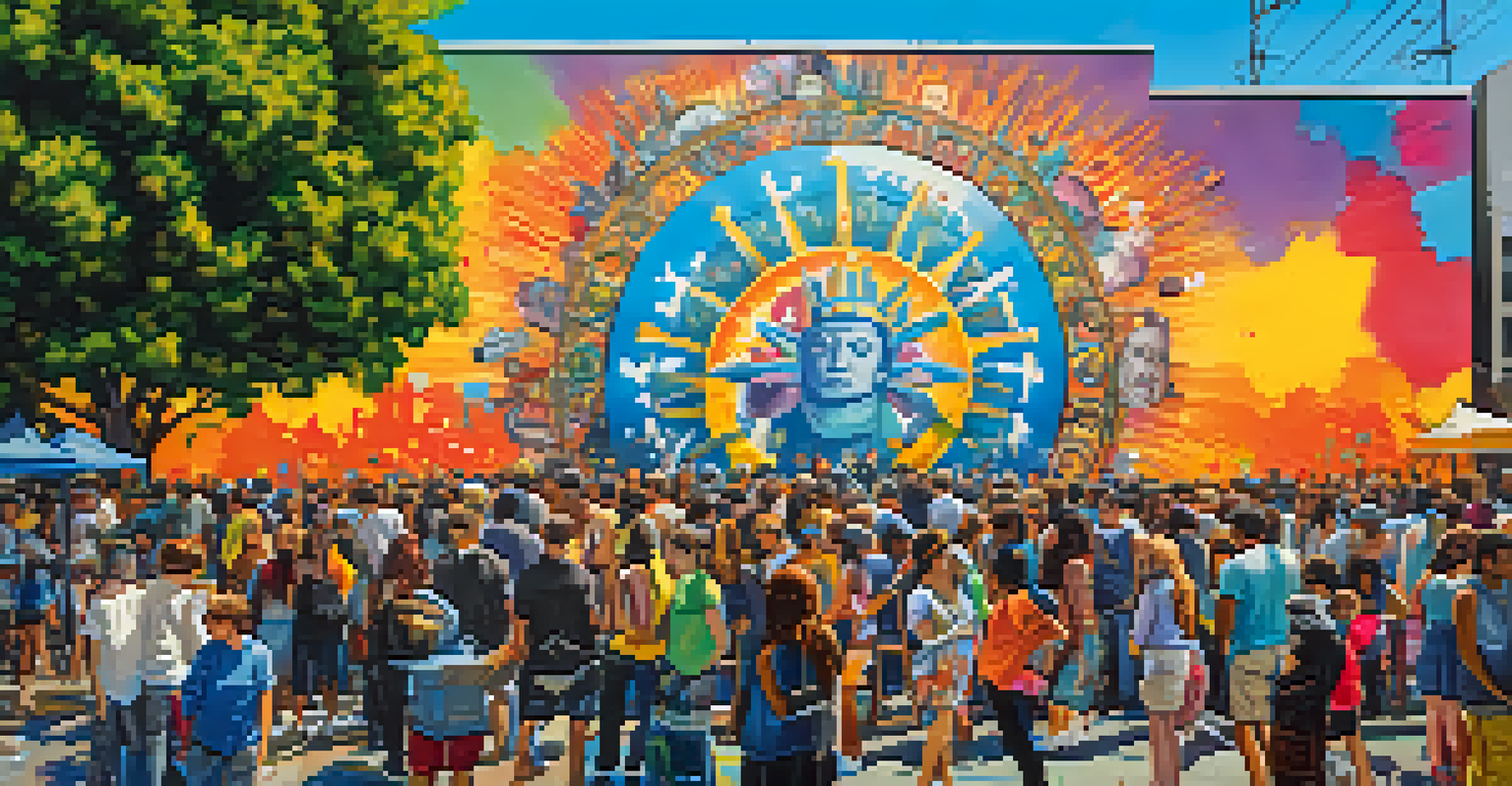Exploring California's Iconic Street Art and Urban Culture Scene

The Roots of California's Street Art Movement
California's street art scene has deep roots that trace back to the 1970s and 1980s. It emerged as a form of self-expression, primarily in urban areas, where artists sought to reclaim public spaces. Cities like San Francisco and Los Angeles became hotbeds for graffiti and mural art, reflecting the diverse cultures and communities within them.
Art is not what you see, but what you make others see.
This movement was not just about art; it was a response to social issues, political unrest, and the desire for visibility. Artists used their work to comment on everything from civil rights to environmental concerns, turning city walls into canvases that told powerful stories. Over the years, these vibrant murals transformed neighborhoods, giving them a unique identity.
Today, street art continues to evolve, incorporating various styles and mediums. The original graffiti artists laid the groundwork, and now a new generation of creators is blending traditional techniques with modern influences, making California's street art scene a dynamic and ever-changing landscape.
Must-Visit Cities for Street Art Enthusiasts
When it comes to experiencing California's street art, certain cities stand out. Los Angeles, with its iconic murals in neighborhoods like Arts District and Boyle Heights, offers a treasure trove of visual delights. Each mural tells a story, inviting passersby to pause and reflect, making it a vibrant gallery under the sun.

San Francisco is another hotspot, where the Mission District showcases bold and colorful murals that celebrate the area's rich Latino heritage. Walking through these streets feels like venturing into an open-air museum, filled with art that speaks to both local history and contemporary issues. Don't forget to check out the famed Clarion Alley, known for its ever-changing art.
California's Street Art Origins
The street art movement in California began in the 1970s and 1980s as a form of self-expression, responding to social issues and reclaiming public spaces.
Further up the coast, Oakland has emerged as a canvas for social commentary and artistic expression. The city’s street art scene is distinguished by its focus on community issues, often showcasing work that highlights activism and solidarity. Each city offers its unique flavor, making it a delightful adventure for art lovers.
The Artists Behind the Murals
Behind every mural is a story and a talented artist with a vision. Many street artists in California began their journeys as graffiti writers, honing their skills on the streets before transitioning to larger, sanctioned projects. Artists like Shepard Fairey and Retna have gained international acclaim, but they remain deeply rooted in the local scene.
The greatest art is the art of living.
These artists often collaborate with community members to ensure their work resonates with the people who live there. By engaging with local narratives, they create art that is not only visually stunning but also culturally significant. This collaboration helps to foster a sense of ownership and pride among residents.
Moreover, many street artists participate in festivals and exhibitions, further bridging the gap between street art and the art world. Events like the Los Angeles Street Art Festival showcase these talents, providing a platform for emerging artists to gain exposure while enriching the urban landscape.
Street Art as a Form of Activism
Street art has long been a powerful medium for activism and social change. In California, murals often address pressing societal issues such as racial inequality, climate change, and immigration reform. Artists use their work to spark conversations and provoke thought, making the streets a stage for important dialogues.
For example, the Black Lives Matter movement has inspired countless murals across the state, with artists creatively expressing solidarity and hope. These pieces not only beautify the environment but also serve as poignant reminders of the struggles and achievements of marginalized communities.
Art as Activism in Murals
Street art in California serves as a powerful medium for activism, addressing critical societal issues like racial inequality and climate change through vibrant murals.
This blend of art and activism creates a unique cultural landscape where creativity meets consciousness. Street art becomes a voice for the voiceless, making it an essential element of California's urban culture and a reflection of its diverse population.
Exploring the Techniques of Street Artists
California's street artists employ a variety of techniques that make their work stand out. From spray paint to stencils and murals, each artist has a distinct style that contributes to the overall character of the city's landscapes. Some artists even incorporate mixed media, using materials like wood, fabric, or recycled objects to create textured pieces.
The use of spray paint is perhaps the most recognized technique in street art, allowing for bold colors and intricate designs. Stencils, on the other hand, offer artists the ability to replicate their work quickly, making them popular for social messages and campaigns. This blend of spontaneity and planning is what makes street art so fascinating.
As these techniques evolve, many artists are also embracing technology, utilizing digital tools to plan their designs before bringing them to life on the streets. This fusion of traditional and modern methods not only pushes the boundaries of creativity but also ensures that California's street art scene remains fresh and innovative.
The Role of Street Art Festivals
Street art festivals play a crucial role in celebrating and promoting the vibrant urban culture of California. Events like the Pow! Wow! festival in Long Beach and the San Francisco Street Art Festival bring together local and international artists to create large-scale murals, transforming neighborhoods into colorful galleries.
These festivals not only showcase artistic talent but also foster community engagement. Residents often participate in workshops, discussions, and guided tours, learning about the artists and the stories behind the art. This immersive experience deepens the connection between the community and the art, creating a sense of pride and ownership.
Influential Street Art Festivals
Street art festivals in California promote community engagement and showcase artistic talent, transforming neighborhoods into dynamic cultural landscapes.
Additionally, festivals provide a platform for emerging artists to gain exposure and connect with established figures in the street art scene. This collaborative environment nurtures creativity and innovation, ensuring that California's street art continues to thrive and evolve.
The Future of Street Art in California
As we look to the future, California's street art scene shows no signs of slowing down. With a growing number of artists, festivals, and community initiatives, the landscape is constantly shifting. This dynamic environment not only attracts tourists but also inspires local artists to push their creative boundaries.
Moreover, the increasing recognition of street art as a legitimate art form opens doors for collaboration with galleries and institutions. As street art gains more visibility, it encourages a dialogue about the value of public art and its role in urban culture, further integrating it into the fabric of California's cities.

However, challenges remain, such as issues of gentrification and the preservation of public art. As neighborhoods change, artists and communities must navigate these complexities to ensure that the spirit of street art continues to thrive, making California an enduring beacon of creativity and cultural expression.